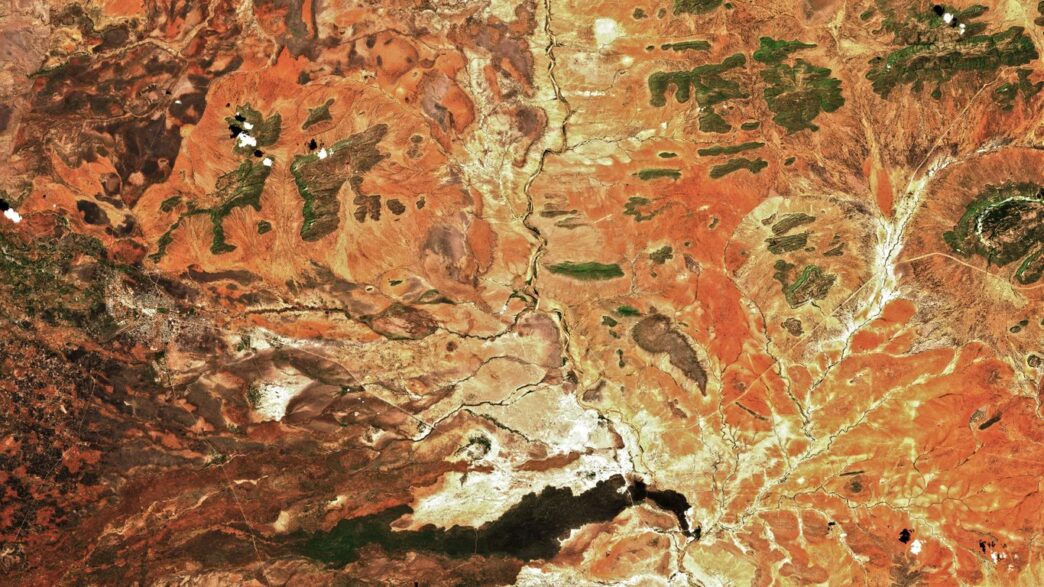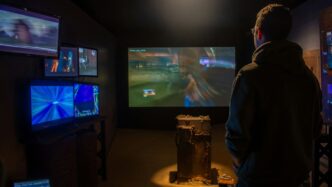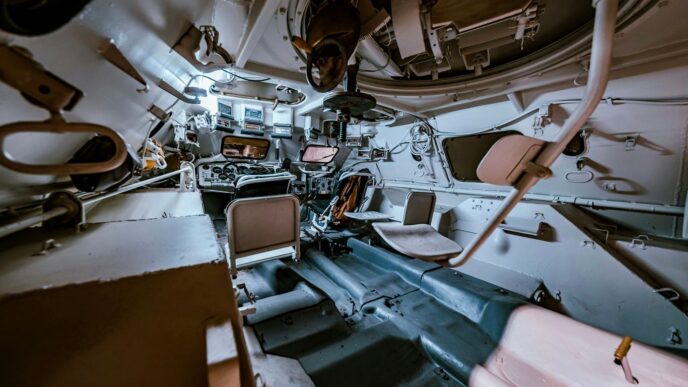Maxar Technologies Rebrands to Vantor: A New Era for Geospatial Intelligence
Understanding the Maxar Technologies Rebranding
So, Maxar Technologies is now Vantor. It’s a pretty big change, and honestly, it’s got a lot of people in the geospatial world talking. This isn’t just a simple name swap; it signals a shift in how the company sees itself and its place in the market. Think of it like a business deciding to go all-in on a new direction. They’re not just tweaking things; they’re rebranding to reflect a future they’re aiming for. It’s a move that suggests they believe their old identity didn’t quite capture what they’re becoming.
The Significance of the Vantor Name Change
Why Vantor, though? The name itself sounds… well, different. It doesn’t immediately scream ‘satellites’ or ‘maps.’ This suggests a move away from just being a provider of satellite imagery. It hints at something broader, perhaps more integrated. Maybe they’re looking to be seen as a solutions provider, not just a data supplier. It’s like changing your name from ‘Bob’s Plumbing’ to ‘AquaFlow Solutions’ – it implies a wider range of services and a more modern approach. This rebranding is a clear signal that Vantor aims to be more than just a satellite company; they’re positioning themselves as a leader in advanced intelligence solutions.
Implications for the Geospatial Industry
What does this mean for everyone else in the geospatial game? Well, it puts a bit of pressure on them, for starters. When a major player like Maxar (now Vantor) makes a bold move like this, it often forces competitors to re-evaluate their own strategies. Are they keeping up? Are they offering what the market is starting to demand? It could mean more investment in AI, more focus on data analysis, and a push for more integrated platforms. We might see other companies follow suit, or perhaps double down on their niche. It’s a dynamic shift that could reshape how geospatial intelligence is developed and used across various sectors, from defense to commercial applications.
The Evolving Landscape of Geospatial Intelligence
The world of intelligence gathering is changing fast, and geospatial intelligence, or GEOINT, is right at the heart of it. It’s not just about looking at pretty satellite pictures anymore. We’re talking about taking all sorts of data tied to a specific location and making sense of it. Think of it like putting together a giant jigsaw puzzle, but instead of a picture, you’re building a story, piece by piece.
Advancements in Satellite Imagery and Data Analysis
Satellites are getting better all the time, capturing images with more detail than ever before. But raw images are just the start. The real magic happens when analysts process and examine this data. They can figure out things like the size of a new building, changes in terrain over time, or even track vehicle movements. This detailed analysis helps paint a clearer picture of what’s happening on the ground, even from miles above. It’s a far cry from just looking at a map; it’s about understanding the dynamic environment.
The Role of AI in Geospatial Intelligence
Artificial intelligence is really shaking things up. AI can sift through massive amounts of data way faster than any human could. It can spot patterns and anomalies that might otherwise be missed. For example, AI can help identify potential threats by analyzing patterns in satellite imagery or sensor data. It’s like having a super-powered assistant that never gets tired and can process information at lightning speed. This allows analysts to focus on the bigger picture and make more informed decisions.
Integrating Geospatial Data with Other Intelligence Disciplines
GEOINT doesn’t work in a vacuum. The real power comes when it’s combined with other types of intelligence. Think about Human Intelligence (HUMINT), where information comes from people, or Signals Intelligence (SIGINT), which involves intercepting communications. By layering GEOINT with these other sources, analysts can build a much more complete understanding of a situation. For instance, knowing where something is (GEOINT) and who is involved (HUMINT) can provide a much richer context than either piece of information alone. It’s about connecting the dots across different intelligence streams to get the full story.
Vantor’s Strategic Vision and Future Offerings

So, Maxar is now Vantor. What does this rebranding actually mean for what they plan to do next? It seems like they’re really pushing hard into using artificial intelligence, or AI, to make their geospatial tools smarter and more useful. Think of it as moving beyond just showing you a picture from space to actually helping you understand what’s happening in that picture, and maybe even predicting what might happen next.
Focus on AI-Driven Solutions
This is a big one. Vantor is betting that AI is the future. They’re not just talking about AI in a general sense; they’re looking at how it can sift through massive amounts of satellite data – way more than any human could ever look at – to find patterns and insights. This could mean spotting changes on the ground that are too small or too subtle for us to notice, or tracking movements over time. The goal is to turn raw data into actionable intelligence, quickly and efficiently. They’re building systems that can learn and adapt, getting better at identifying threats or opportunities as they process more information. It’s like having a super-smart assistant that’s constantly watching the world from above.
Enhanced Capabilities for Defense and National Security
For folks in defense and national security, this is where things get really interesting. Vantor is aiming to give warfighters and intelligence analysts better tools to understand what’s going on around them. Imagine getting real-time updates on enemy positions, or having AI help predict potential conflict zones based on subtle changes in activity. They’re working on systems that can help with:
- Situational Awareness: Giving soldiers a clearer picture of their surroundings, including where friendly forces are and potential threats.
- Faster Decision-Making: Processing information so commanders can make choices more quickly, which is obviously a big deal when lives are on the line.
- Networked Operations: Helping different units and systems communicate and share information more effectively, creating a more connected battlefield.
They’re also looking at ways to secure these high-tech systems, making sure they can’t be easily disrupted by hackers, which is a growing concern as more military gear becomes connected.
Expanding Market Reach and Applications
While defense is a major focus, Vantor isn’t stopping there. They see AI-powered geospatial intelligence being useful in a lot of different areas. Think about:
- Disaster Response: Quickly assessing damage after a natural disaster to help coordinate relief efforts.
- Infrastructure Monitoring: Keeping an eye on critical infrastructure like pipelines or power grids for any signs of trouble.
- Environmental Monitoring: Tracking changes in the environment, like deforestation or water levels, over time.
By making their tools more intelligent and adaptable, Vantor hopes to open up new markets and find new ways for people to use satellite data. It’s about making this powerful information accessible and useful for a wider range of problems, not just the traditional intelligence and defense sectors.
Impact on Defense and National Security Sectors

The rebranding of Maxar Technologies to Vantor signals a significant shift in how defense and national security agencies will interact with geospatial intelligence. It’s not just about prettier maps anymore; it’s about making faster, smarter decisions in complex environments. Think about it: the battlefield is getting more connected, and the amount of data coming in from all sorts of sensors is just exploding. Trying to make sense of it all in real-time, especially when things are heating up, is a huge challenge for our warfighters and commanders.
Improving Situational Awareness for Warfighters
One of the biggest wins here is how Vantor’s tech can help soldiers on the ground know what’s happening around them. Imagine a patrol out in a tricky area. Instead of just relying on what they can see or hear, they could get real-time updates on enemy movements, potential threats, or even changes in the terrain, all pulled together from various sources. This isn’t about overwhelming them with more screens, though. The idea is that AI will filter all that noise and just give them the critical information they need, right when they need it. This helps them avoid ambushes, find safer routes, and generally stay one step ahead.
Accelerating Decision-Making Processes
For commanders, time is always of the essence. Vantor’s focus on AI-driven solutions means that the time it takes to go from observing a situation to acting on it can be drastically cut down. AI can sift through massive amounts of data from satellites, drones, signals intelligence, and more, identifying patterns and potential threats that a human analyst might miss or take much longer to find. This allows for quicker assessments of enemy intentions, better planning of operations, and more agile responses to developing situations. It’s like having a super-powered assistant that can process information at lightning speed, helping leaders make better calls, faster.
Securing the Networked Battlefield
As military operations become more reliant on interconnected systems and data sharing, the risk of cyberattacks and information disruption grows. Vantor’s advancements are also looking at how to keep these critical systems online and secure. This includes developing ways to protect the hardware and software that soldiers and command centers rely on, making sure that even if one part of the network is compromised, the whole system doesn’t go dark. Keeping the flow of information secure and uninterrupted is just as important as having that information in the first place. This focus on resilience is key to maintaining an advantage in a future where battles could be fought as much in the digital space as on the physical ground.
Challenges and Opportunities in the Geospatial Intelligence Field
So, you’ve got all this amazing satellite data, right? The problem is, it’s like trying to drink from a firehose sometimes. We’re talking about mountains of information, and figuring out what’s actually important can be a real headache. The biggest hurdle is turning raw data into actionable intelligence without overwhelming the people who need it. It’s not just about having the tech; it’s about making sense of it all.
Addressing Information Overload for End-Users
Think about it. Analysts are sifting through images, sensor readings, and all sorts of other data. If you’re not careful, you can get lost in the weeds. It’s easy to ask questions that are too broad and miss key details, or ask questions that are so specific you don’t have enough context. The goal is to get the right information to the right person at the right time, not just dump everything on their desk. It’s a slow process, building up understanding piece by piece, not like flipping a switch.
The Importance of Data Security and Integrity
This stuff is sensitive. We’re talking about national security, defense, and all sorts of critical operations. So, making sure the data is accurate and hasn’t been messed with is a huge deal. If the information is wrong or compromised, decisions based on it could be disastrous. It’s like building a house on a shaky foundation – it’s just not going to end well. Keeping this data locked down and trustworthy is non-negotiable.
Navigating the Competitive Geospatial Market
It’s not just Vantor out there. There are a lot of companies doing cool things with geospatial data. This competition is actually a good thing, though. It pushes everyone to get better, to innovate faster, and to find new ways to solve problems. For companies like Vantor, it means constantly proving their worth and showing how their solutions are a step above the rest. It’s a dynamic field, and staying ahead means always looking for that next big idea.
The Future of Maxar Technologies (Vantor) and Its Competitors
So, Maxar is now Vantor. What does this rebranding really mean for the company and, more importantly, for everyone else playing in the geospatial intelligence sandbox? It’s a big move, and it signals a shift in how companies are thinking about this whole data game.
Competitive Advantages of Vantor
Vantor is betting big on AI. They’re not just talking about it; they’re building it into their core. Think about it: instead of just giving you a bunch of satellite pictures, they want to use artificial intelligence to sift through all that data and tell you what’s actually important. This could mean faster insights for defense clients, helping them understand what’s happening on the ground without having to stare at screens for hours. They’re also looking to make their systems more secure, using things like embedded chips instead of just software for encryption. This is a smart move because, let’s face it, if your high-tech gear gets hacked, it’s pretty much useless.
Potential Market Disruptions
This whole AI push could really shake things up. Right now, a lot of the advanced tech is stuck at the higher levels of intelligence agencies. But Vantor seems to be aiming to bring some of that power down to the soldier in the field. Imagine a future where a soldier has augmented reality showing them where friendly forces are, or even potential threats, right in their helmet. That’s a game-changer. However, it’s not going to happen overnight. We’re talking years, maybe even decades, before we see that kind of sci-fi stuff become standard issue. The biggest hurdle is making sure all this tech doesn’t just overwhelm the person using it. Nobody wants more information when they’re trying to stay alive; they want the right information, at the right time.
The Broader Impact on the Intelligence Community
Ultimately, Vantor’s move is part of a larger trend. The intelligence community is drowning in data. AI is seen as the life raft. Companies like Vantor are trying to build better tools to help process all that information, making decision-making faster and more effective. This isn’t just about making pretty maps anymore; it’s about using data to gain an edge. The companies that can successfully integrate AI and deliver actionable intelligence, without adding to the soldier’s burden, are the ones that are going to lead the pack. It’s a race to see who can best turn raw data into smart decisions on the battlefield.
What’s Next for Vantor?
So, Maxar is now Vantor. It’s a big change, and it makes you wonder what’s coming next for the world of geospatial intelligence. While the name change itself doesn’t instantly change how satellites see the Earth, it signals a new direction. We’ll likely see Vantor focus more on how its data and tech can be used, especially with AI becoming a bigger deal. Think about how this could help with everything from mapping out disaster zones to maybe even aiding soldiers on the ground, though that last part might still be a ways off. It’s a space to watch, for sure.














